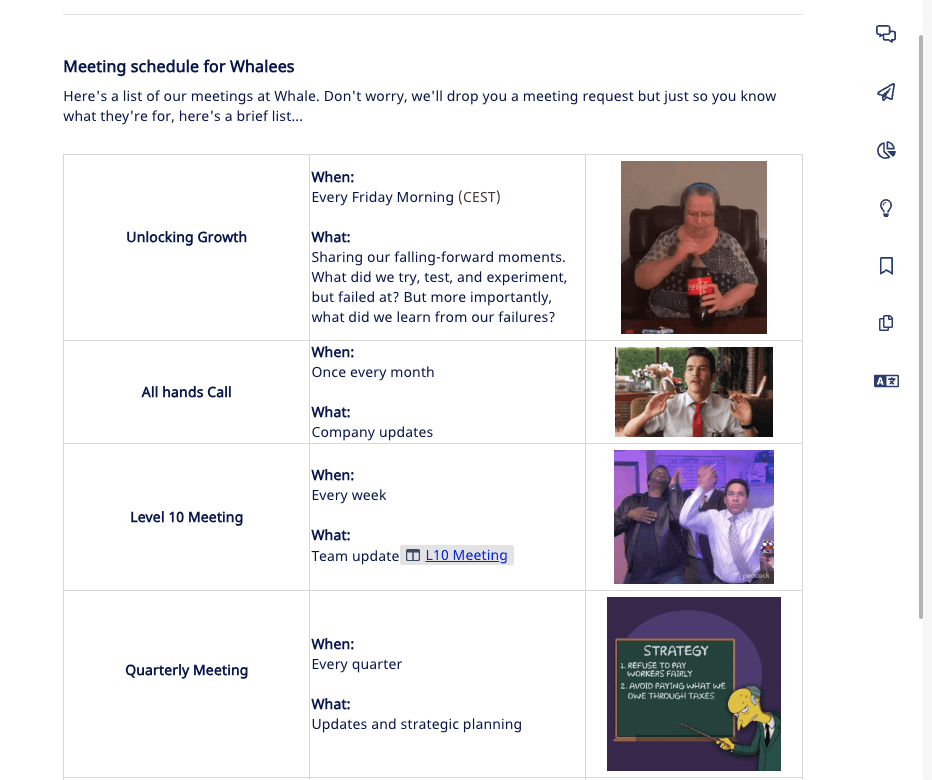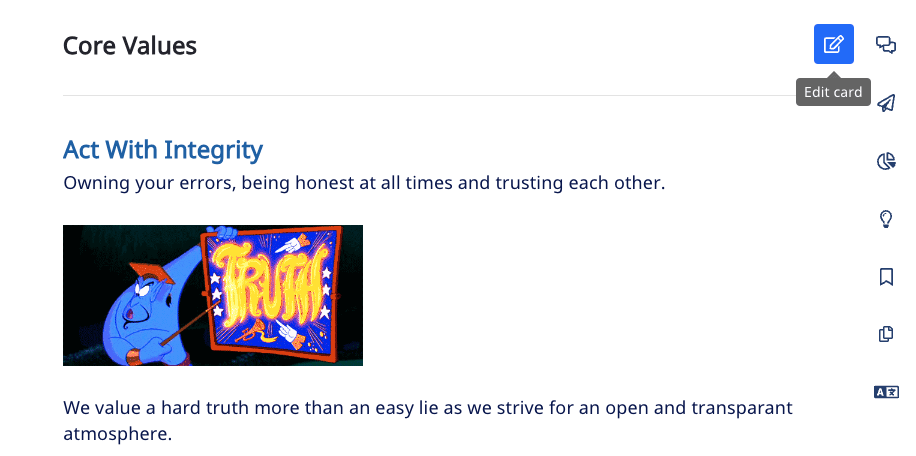Standard Operating Procedures don’t have to be boring.
Unfortunately, not everyone’s received the memo, and there are still a ton of businesses out there suffering from outdated documentation and bored employees.
So, how do you leap ahead of the competition and create epic SOPs that employees truly love?
We’ll show you. Here’s what to do (and what not to do) to make your SOPs stand out from the same-old (+ some pick-and-play SOP examples).
The Anatomy of an Effective SOP
An effective SOP is more than just a list of steps; it’s a carefully crafted document that’s both comprehensive and easy to understand.
Here’s what makes an SOP stand out:
- Clarity: Each step is clearly defined, leaving no room for ambiguity.
- Conciseness: Information is presented succinctly, making it easy to follow.
- Consistency: The format is uniform across all SOPs within an organization, making them easy to navigate.
- Accessibility: SOPs are readily available to all relevant team members, ensuring they can be referenced at any time.
3 TOP SOP examples 🏆
Okay, now we’ve got what not to do out of the way, let’s dive into some of the best ways to approach SOPs.
Find out how to engage employees and boost productivity with these unmissable SOP examples.
1. Best SOP Example 1 - Win using video
Humans are visual creatures — in fact, half of the brain is directly or indirectly devoted to processing visual information.
And when it comes to learning, according to American psychologist William Glasser, “We learn… 10% of what we read, 20% of what we hear, 30% of what we see, 50% of what we both hear and see.”
In other words, here’s what to prioritize when it comes to creating engaging SOPs:
- Video
- Images
- Audio
- Text
So, next time you’re creating an SOP, remember to keep it as visually stimulating as possible. Go all out! It works for Netflix, keeping audiences engaged! So it’ll work for you!
Great SOPs use video to make magic!
Video should be part of every SOP and you don’t need a production studio to do it! We created the above video in just a few minutes!
Let’s break it down:
- Choose a training and knowledge platform that allows you to use image, video, and gifs to up your SOP engagement levels (we know one that fits the bill 😉).
- Add screenshots and video screen (or even GIFs as we love!) shares that show exactly how to run the process.
2. Best SOP Example - Win by writing like a human
A quick Google search of ‘Standard Operating Procedure’ immediately draws out words like ‘Efficiency’ and ‘Routine’ — not very inspiring for employees hoping to actually enjoy their day at work.
Injecting some fun into SOPs can be as simple as upping your lingo game and writing SOP content as though you’re speaking to humans (because you actually are). A conversational tone of voice, workplace in-jokes, and even employee nicknames can go a long way.
Great SOPs talk like you would!
Instead of:
Meetings are conducted on a weekly basis and are to be attended by all personnel….blah blah blah long document style speech.
Try something like this SOP example instead;

Let’s break it down:
- Write like you’re speaking to humans (because you are).
- Stick to a conversational tone of voice.
- Add workplace in-jokes or team nicknames whenever appropriate.
- Don’t be afraid to abbreviate words (as long as it still makes sense).
3. Best SOP Example - Make it accessible to everybody!

We hate to say it but if your SOPs aren’t easy to access, your employees probably won’t bother to use them.
The key is to create a personalized experience for each role and only give employees the SOPs they actually need.
Here’s how:
- Choose just one place to share SOPs: Make sure employees know exactly where to look for their SOPs by keeping them in one place. All-in-one knowledge and training platforms are a great way to manage SOPs so no one ever needs to ask ‘Where does that live?’ again.
- Make sure employees have only what they need: Employees no longer need heavy handbooks that tell them everything about the company. Give employees what they need (and only what they need) so they don’t get weighed down with unnecessary details.
- Keep SOPs updated: Over time, SOPs can get a little rusty as procedures improve on the ground. Schedule regular updates to keep your procedures as efficient as possible.
Great SOPs are ALWAYS accessible! You’re team shouldn’t have to go looking for them either.
Let’s break it down:
- Choose an all-in-one knowledge and training platform that allows you to keep all your SOPs in one place.
- Only give your employees access to the SOPs they need to avoid overwhelm.
- Schedule regular SOP updates to keep your processes as relevant as possible.
Essential SOP examples and templates
Okay, so you’re ready to try creating SOPs of your own. Here are a few templates to get you started.
Welcome to the Company SOP
The welcome to the company section of an employee handbook is an important introduction to the organization for new employees.
Hiring Process SOP
This template is your guide to hiring the best talent for open roles in your company.
30-60-90 Day Onboarding Plan SOP
A step-by-step plan to onboard new employees successfully in their first months
3 real-life examples of SOPs gone wrong 😩
Unfortunately, there are way too many companies out there that don’t prioritize great Standard Operating Procedures.
The outcome? Frustrated, bored employees who would rather jump ship than deal with any more roadblocks.
But don’t just take our word for it.
Here are some real-life examples of what happens when SOPs don’t work.
Bad SOP example #1: SOPs in a million and one places
Making engaging SOPs is just one hurdle to jump — because if your employees don’t know where to look for the information, you might as well not have bothered to write it at all.
One Reddit user explained how messy SOP management works (or not) in their company:
“[Around 20% of our SOPs] are tracked in a hodgepodge way, ranging from paper forms, PDF files, Excel sheets, Monday.com boards, an individual’s memory, etc… The reason for the variety, I think, is because of acquisitions over time and differences in comfort levels with technology among the team. It is certainly not a best practice to have so many different places to capture this information,” they explained.
But unfortunately for them (and 23% of workers), there’s just not enough time in the workday to make it right — which means they have to suck it up.
“It is a source of frustration for me at times (love the process and think it adds to the enterprise) but I accept it and focus efforts where things are mission-critical,” they said.
Here’s how to avoid messy SOP management:
- Make a list of all the SOPs your company already has and where they live (including those hanging around in employees’ heads).
- Prioritize each one depending on the risk of losing information (eg, if an employee leaves will they take that information with them?).
- Figure out who is the best person to write the SOP and give them a solid deadline to get it done.
Bad SOP example #2: Outdated, lengthy SOPs
It’s not just SOP management that can bring employees down. If processes aren’t clear, the outcome can be just as damaging — as this Reddit user found out.
“I’ve had a handful of similar jobs in the past and always kinda muddled through [but this new company] has stumped me: There are 46 pages of documentation for onboarding a new starter. There are 182 AD templates for new users. Despite the lengthy docs, no ‘decisions’ are actually made in it, lots of ‘unless specified otherwise’,” he said.
But the real problem? Finding a way to tell management their processes suck.
“How can I phrase ‘I’m really sorry boss, I am trying my best but none of the processes or docs make sense or have been updated since 2012’?” asked the Reddit user.
Bad SOP example #3: Top-down SOPs
- Give employees opportunities to feedback about SOPs — and take their comments on board.
- Go through SOPs with a fine-tooth comb and ask yourself ‘Do we really need to say this?’
- Schedule time for regular SOP updates so documentation is as up-to-date and streamlined as possible.
Another Reddit user found herself in a difficult position too — five months into a role with a large multinational, unsure about her new company.
The problem? Too many unclear processes and an ‘our-way-or-the-highway’ approach to systems.
“I’m spending 8-12 hours/week frustrated about roadblocks (unclear processes, cumbersome systems, finding/chasing the right contacts, technology bugs, and, of course, time zone differences)… It’s rare that I’m asked to make recommendations or given the opportunity to do so. When I’ve voiced these concerns, I’m told variations of This is the way this company, and every large company operates. Influence what you can, and build resilience to what you can’t change,” she says.
Bottom Line?
Gone are the days of yawn-worthy Standard Operating Procedures (SOPs) – these days, great procedures are all about engagement.
Document process issues impact the bottom line. Fully addressing those gaps could yield a whopping 36% increase in revenue, creating engaging SOPs is clearly worth the effort.
But it’s a whole lot easier to do with the right software!
Sign up for a free account in Whale and start creating SOPs in seconds!
FAQs about SOP examples
How do you improve your SOPs?
- Ask the employees who actually do the work whether they have any recommendations to make the process more efficient.
- Be open to change — if a process isn’t working, find a better way.
- Give everyone the opportunity to input into SOPs, even if they’re not management.
Hear a familiar theme in all of the above? Yes, it’s all about feedback and being open to continuous improvement.
What is the best SOP format example?
Every SOP should have these elements;
- Title: Each SOP starts with a clear, descriptive name. It is helpful to include the department name and the last review date.
- Summary of purpose: What is the SOP for?
- Responsibilities: This section describes who the document is for
- Scope: Define who or what the process applies to
- Purpose: The main objective of the procedure is highlighted here.
- Glossary: If terminology or abbreviations are used, they should be explained in the glossary.
- Procedure: Here’s where you document the steps of the activity. Remember, only include the steps necessary – don’t go into every detail.
- References: Helpful links to relevant resources should be included in the reference section.
- Date of last revision
You may want to check out "How to write a Standard Operating Procedure" for more details.
How do you make sure your team reads your SOPs?
Lead the way with visual SOP examples!
Standard Operating Procedures have a bad rap for being… well, standard. But in a competitive business world, it’s time for that to change.
With the right tools and an eye for engagement, you can easily up your SOP game by creating procedures that employees actually enjoy reading (or watching, or listening to 😉).
If you show employees how it can be done, before long engaging SOPs will become the norm — and so will happy employees and a solid bottom line.
Want to scale your business with killer SOPs employees actually love?
Key Terms & Further Reading on SOP Examples
What is your greatest challenge?
SOP & Process Documentation
Use Whale to create SOP & Process Documentation and centralize everything in an easily accessible single source of truth.
Employee Onboarding & Training
Whale is the fastest way to get your team aligned. Discover how Whale boosts team performance and ensures new hires excel from the get-go.
Companies on EOS ®
Whale is the all-in-one system for teams running on EOS® to help document your processes, train your teams, and build a foundation for growth.







